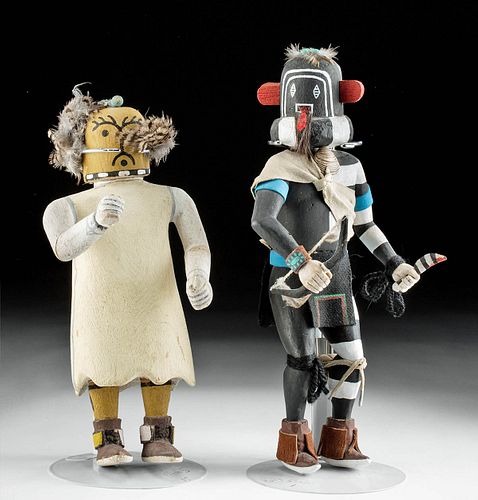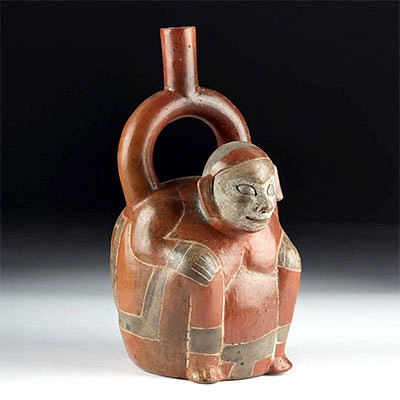Pair of 20th C. Hopi Wood Kachinas - Left Hand & Kokole
Lot 229
About Seller
Artemis Fine Arts
686 S Taylor Ave, Ste 106
Louisville, CO 80027
United States
Selling antiquities, ancient and ethnographic art online since 1993, Artemis Gallery specializes in Classical Antiquities (Egyptian, Greek, Roman, Near Eastern), Asian, Pre-Columbian, African / Tribal / Oceanographic art. Our extensive inventory includes pottery, stone, metal, wood, glass and textil...Read more
Estimate:
$550 - $825
Absentee vs Live bid
Two ways to bid:
- Leave a max absentee bid and the platform will bid on your behalf up to your maximum bid during the live auction.
- Bid live during the auction and your bids will be submitted real-time to the auctioneer.
Bid Increments
| Price | Bid Increment |
|---|---|
| $0 | $25 |
| $300 | $50 |
| $1,000 | $100 |
| $2,000 | $250 |
| $5,000 | $500 |
| $10,000 | $1,000 |
| $20,000 | $2,500 |
| $50,000 | $5,000 |
| $100,000 | $10,000 |
| $200,000 | $20,000 |
About Auction
By Artemis Fine Arts
Jul 8, 2021
Set Reminder
2021-07-08 10:00:00
2021-07-08 10:00:00
America/New_York
Bidsquare
Bidsquare : CLEARANCE | Ancient & Ethnographic Art
https://www.bidsquare.com/auctions/artemis-gallery/clearance-ancient-ethnographic-art-7173
Kick off summer with our clearance sale featuring discounted pricing and many new items at superb prices! Asian art, Classical antiquities from Egypt, Greece, Italy, and the Near East...plus Pre-Columbian, Tribal, Russian Icons & Enamelware, Spanish Colonial, Fine Art, Fossils, more! Artemis Fine Arts info@artemisfinearts.com
Kick off summer with our clearance sale featuring discounted pricing and many new items at superb prices! Asian art, Classical antiquities from Egypt, Greece, Italy, and the Near East...plus Pre-Columbian, Tribal, Russian Icons & Enamelware, Spanish Colonial, Fine Art, Fossils, more! Artemis Fine Arts info@artemisfinearts.com
- Lot Description
**Originally Listed At $300**
Native American Indian, Southwest, Hopi, ca. mid-20th century CE. A fascinating pair of hand-carved and hand-painted wooden katsina/kachina dolls; a taller figure known as a Left Hand kachina and a shorter figure called a Kokole. Holding a bow in his right hand and a knife in his left, the Left Hand kachina features a body painted with black and white stripes and dressed in a beige felt sash, a black felt loin cloth, burgundy shoes, a shell necklace, a leather bracelet, turquoise arm bands, and a turquoise belt. His black-painted head has a thick, vertically striped band at its base and a projecting, red beak, flanked by a pair of rhomboid eyes. A tuft of feathers caps his stylized visage. Alternatively, the Kokole (also Qoqle or Cocole) figure wears a long, cream-colored robe that ends at his knees, exposing his yellow shins and maroon shoes. White pigment envelops his bent arms and fisted hands. His yellow head is decorated with bird feathers and displays a petite blue bird sitting at its top. Kachina figures are meant as gifts for children representing kachina dancers and the supernatural katsinam beings they embody. Size (of largest): 5.875" W x 12" H (14.9 cm x 30.5 cm); 12.1" H (30.7 cm) on included custom stand.
Plaza Dances may be either Mixed Katsina Dances (Soyohim) in which dancers representing all the different types of katsinas attend, or a dance that includes only katsinas of the same type. Regardless, in addition to bringing about rain and fertility, all katsinas have a distinct purpose. Dances may be performed to commemorate a special event such as recovery from an illness, the welcomed return of a son from the army, or a birthday. Nevertheless, these dances maintain a religion quality for the Hopis.
The Katsinam, supernatural beings who live in the high mountains of the San Francisco Peaks above traditional Hopi territory, speak to the Hopi through costumed dance and song. These dancers emerge from the round ceremonial kivas that are at the center of their communities, singly or in groups, and dance to the music of drums, rattles, and song. Katsina figures (katsina dolls, katsin-tihu), are made of cottonwood root to represent these supernatural beings. Cottonwood is culturally symbolic because the cottonwood tree, once abundant in traditional Hopi lands, grows where water flows - thus, looking across a landscape, lines of cottonwood trees denote a water source in the desert. After carving, the figures are painted all over with whitewash, made from kaolin clay, and then painted in brilliant colors. Originally these were done using yucca brushes. Many katsina are then decorated with other materials, like feathers, cloth, or fur. Katsina dolls are often given objects to hold which indicate their roles.
Provenance: private Colgate, Wisconsin, USA collection, acquired in the 1970s to 1990s
All items legal to buy/sell under U.S. Statute covering cultural patrimony Code 2600, CHAPTER 14, and are guaranteed to be as described or your money back.
A Certificate of Authenticity will accompany all winning bids.
PLEASE NOTE: Due to recent increases of shipments being seized by Australian customs (even for items with pre-UNESCO provenance), we will no longer ship most Antiquities and ancient Chinese art to Australia. For categories of items that are acceptable to ship to Australia, please contact us directly or work with your local customs brokerage firm.
#164051Smaller figure is missing object in proper right hand and has had both arms reattached with break lines visible. Both have expected nicks and abrasions. Otherwise, very nice with excellent pigments.Condition
- Shipping Info
-
All shipping is handled in-house for your convenience. Your invoice from Artemis Gallery will include shipping calculation instructions. If in doubt, please inquire BEFORE bidding for estimated shipping costs for individual items.
-
- Buyer's Premium



 EUR
EUR CAD
CAD AUD
AUD GBP
GBP MXN
MXN HKD
HKD CNY
CNY MYR
MYR SEK
SEK SGD
SGD CHF
CHF THB
THB













